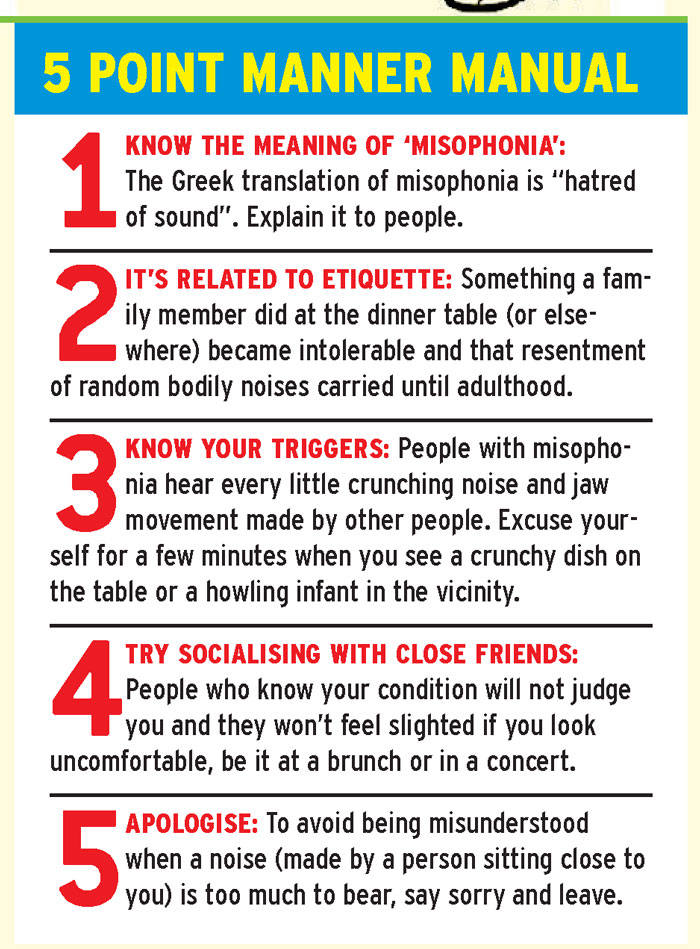Misophonia is a disorder in which certain sounds trigger emotional or physiological responses that some might perceive as unreasonable. Those who have Misophonia might describe it as when a sound “drives you crazy.” Their reactions can range from anger and annoyance to panic and the need to flee. The disorder is sometimes called selective sound sensitivity syndrome.

As of 2016 the literature on misophonia was limited. Some small studies show that people with Misophonia generally have strong negative feelings, thoughts, and physical reactions to specific sounds, which the literature calls “trigger sounds”. These sounds are apparently usually soft, but can appear to be loud. One study found that around 80% of the sounds were related to the mouth (eating, slurping, chewing or popping gum, whispering, whistling, etc.), and around 60% were repetitive. A visual trigger may develop related to the trigger sound. It also appears that a misophonic reaction can occur in the absence of an actual sound.


Reactions to the triggers can include aggression toward the origin of the sound, leaving, remaining in its presence but suffering, trying to block it or trying to mimic the sound.
The first misophonic reaction may occur when a person is young and can originate from someone in a close relationship, or a pet.
Particularly severe cases of Misophonia may result in ferocious instincts toward the source of the sound. One such case described in the journal
Psychiatry and Clinical Psychopharmacology complete ‘involuntary violence’ unveiled by a sufferer in response to a trigger in the form of another person eating loudly.
People with Misophonia are aware they experience it and some expect it to be abnormal; the trouble it causes in their lives ranges from mild to severe. Avoidance and other behaviours can make it harder for people with this condition to achieve their goals and enjoy social relations.
There was very limited data available related with Misophonia till 2016. Little studies were done related with Misophonia which shows that the people with Misophonia generally have strong negative feelings, thoughts, and physical reactions to specific sounds, which are called the “trigger sounds”. These trigger sounds apparently appear to be soft but can appear to be loud. As per one study, around 80% of the sounds are related to the mouth (eating, sucking, chewing or popping gum, whispering, whistling, etc.), and around 60% are repetitive. These trigger sounds can also create a visual trigger which may further lead to misophonic reaction in the absence of an actual sound.
Reactions to the triggers can include aggression toward the origin of the sound, leaving, remaining in its presence but suffering, trying to block it or trying to mimic the sound.
It is observed that the misophonic reaction can occur when a person is in young stages of his/ her age and can originate from someone in a close relationship, or even a pet.
If there is mild reaction of Misophonia, it may feel like:
- Anxious
- Uncomfortable
- The urge to flee
- Disgust
If the response to unhearable sounds is more severe, it might cause:
- Rage
- Anger
- Hatred
- Panic
- Fear
- Emotional distress


The condition of Misophonia does affects the daily life of a person, but it can be learned to manage it.
Treatment often involves a multidisciplinary method merging sound rehabilitation by audiologists and helpful counselling in which managing strategies are highlighted.
A very helpful treatment can be trying to distract one from hearing any of such disturbing sounds by putting a device like a hearing aid that creates a sound in the ear similar to a waterfall. The noise distracts one from triggers and reduces reactions.
Other treatments include talk therapy.
The lifestyle also plays a big role. Getting regular exercise, plenty of sleep, and managing the stress. We can also wear ear plugs and headsets to tune out sounds. Setting up quiet areas or safe spots in the home where no one will make the noises that bother.

